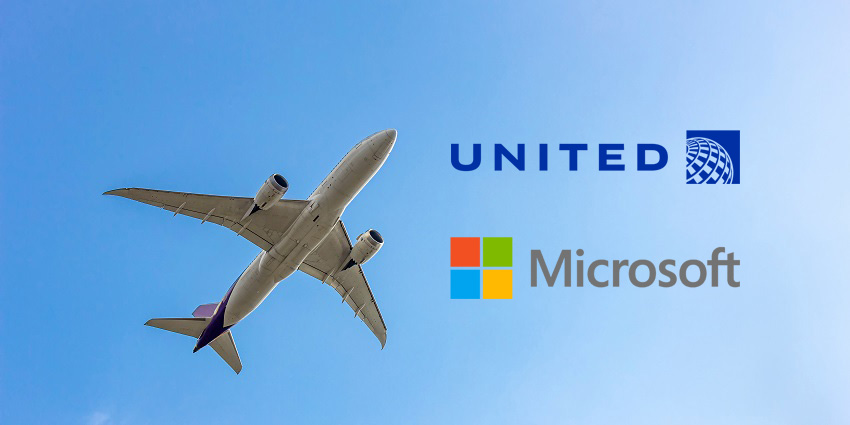The concepts of hybrid work and distributed employees are nothing new to most transportation companies. Most organisations have professionals operating in a variety of settings, from front-of-house teams serving customers, to engineers and back office managers.
United Airlines, one of the biggest transportation companies in the world, was certainly no stronger to the challenges of hybrid communications, even before the pandemic hit. Employees in the workforce had always needed a way to collaborate and connect from anywhere. Yet, for a long time, the business relied heavily on traditional communication tactics. Face-to-face and phone conversations were the norm, often leading to unnecessary travel.
However, when the pandemic hit and the transportation space began to evolve, United Airlines decided it was time to update its communication strategy once and for all. The business leaders turned to Microsoft, and began building their ecosystem in Microsoft 365, with the help of Teams.
Here’s what happened when United Airlines and Microsoft joined forces.
Making Meetings More Dynamic with Microsoft Teams
United Airlines felt it was extremely important to maintain its collaborative culture, even as their hybrid work landscape expanded. The company wanted to introduce tools which would preserve the relationships between their employees, while making communication easier and more efficient.
Microsoft 365 and Microsoft Teams appeared to be the perfect solutions for the company’s unique needs. The impact of Microsoft became particularly apparent when the pandemic hit, and United Airlines was forced to split its Network Operations Centre (NOC) into two segments, with one team working from home, and the other operating from the office.
Teams proved itself to be a more effective option than relying on conference calls alone. According to United Airlines, the issues typically handled over the phone transitioned into Teams, where people could communicate on a face-to-face basis, chat, and share documents more seamlessly. United Airlines also sees Teams as the perfect match for the always-on nature of the airline industry.
As the airline and transportation landscape continues to evolve and recover after the pandemic, United Airlines believes it’s crucial to have the right tools in place to synchronise their workforce, particularly when issues occur. In the event of a snowstorm, for instance, employees can continue to contribute to discussions via Teams, even if they’re kept out of the office.
The ability of the employees in the workforce to simply dive into Teams and get to work as normal has proven to be extremely valuable for United Airlines. The company believes Microsoft is helping them to run a more efficient airline, capable of adapting quickly to disruptions.
Boosting Inclusivity with Live Events
For United Airlines, Teams has also preserved crucial aspects of the company’s culture. For instance, at the Denver International Airport hub for the company, members of “Team Den” can join forces on a daily basis, to share important news and updates. The team engages in two huddles each day with leaders, one in the evening and one in the morning, to accommodate different shifts. In the past, those meetings had been held mainly through conference calls, with a number of issues as a result.
Old-fashioned conference calls often led to people talking over each other, and communication being more strained. However, Teams meetings delivered an immediately beneficial alternative. Through Teams, the company has access to a more straightforward, convenient solution for short meeting. Users can instantly see who’s engaged in the conversation, and the raise-hand feature prevents people from talking over each other. Additionally, the ability to share screens when discussing complex topics has helped many team members to get more value out of each meeting.
Teams has also been extremely beneficial for the company’s town hall meetings, which tend to connect over 100 employees at any given time. Using Teams Live Events, United Airlines has been able to eliminate the need for complex in-person meetings. Initially, there was some resistance from employees to the concept of transitioning to digital events.
However, staff members rapidly discovered how flexible the virtual format really was. Town halls ensured every member of staff had the opportunity to attend and share knowledge, regardless of where they are, or their transportation requirements. Additionally, the live events on Teams can be recorded, so people who do miss the original meeting can watch it whenever they choose.
United Airlines also noted that more reserved team members were able to engage more cohesively with the new format. People don’t have to ask their questions verbally if they feel uncomfortable. Instead, they can simply type questions into a Q&A pane. Employees eventually requested that the virtual meetings be retained, even after in-person meetings were an option again.
Investing in a Dynamic Culture
The Vice President of IT, Engineering, and Operations for United Airlines, Mike Taccino said Teams fits perfectly with the values of the United Airlines company. The culture of the brand is built around the idea that inclusion propels innovation. Teams ensures everyone in the workforce can be seen, and heard, wherever they are. With Teams, United Airlines has been able to empower employees with more flexible options for how they contribute and work together.
United feels the technology has boosted inclusion and innovation extensively. Additionally, Microsoft Teams has helped to streamline some of the common processes in the business, making it easier for employees to communicate in the way that works for them.
United believes its customers will benefit from the dynamic, hybrid culture enabled by Teams too. With employees now able to communicate across a range of different environments, in one convenient space, it’s easier for everyone to deliver better service for customers. The United Airlines team is excited about the future of their business, with Microsoft tools at the helm.
They believe they’re now in the best position possible to deliver excellent experiences for employees and customers alike.







